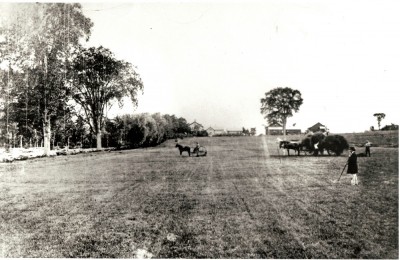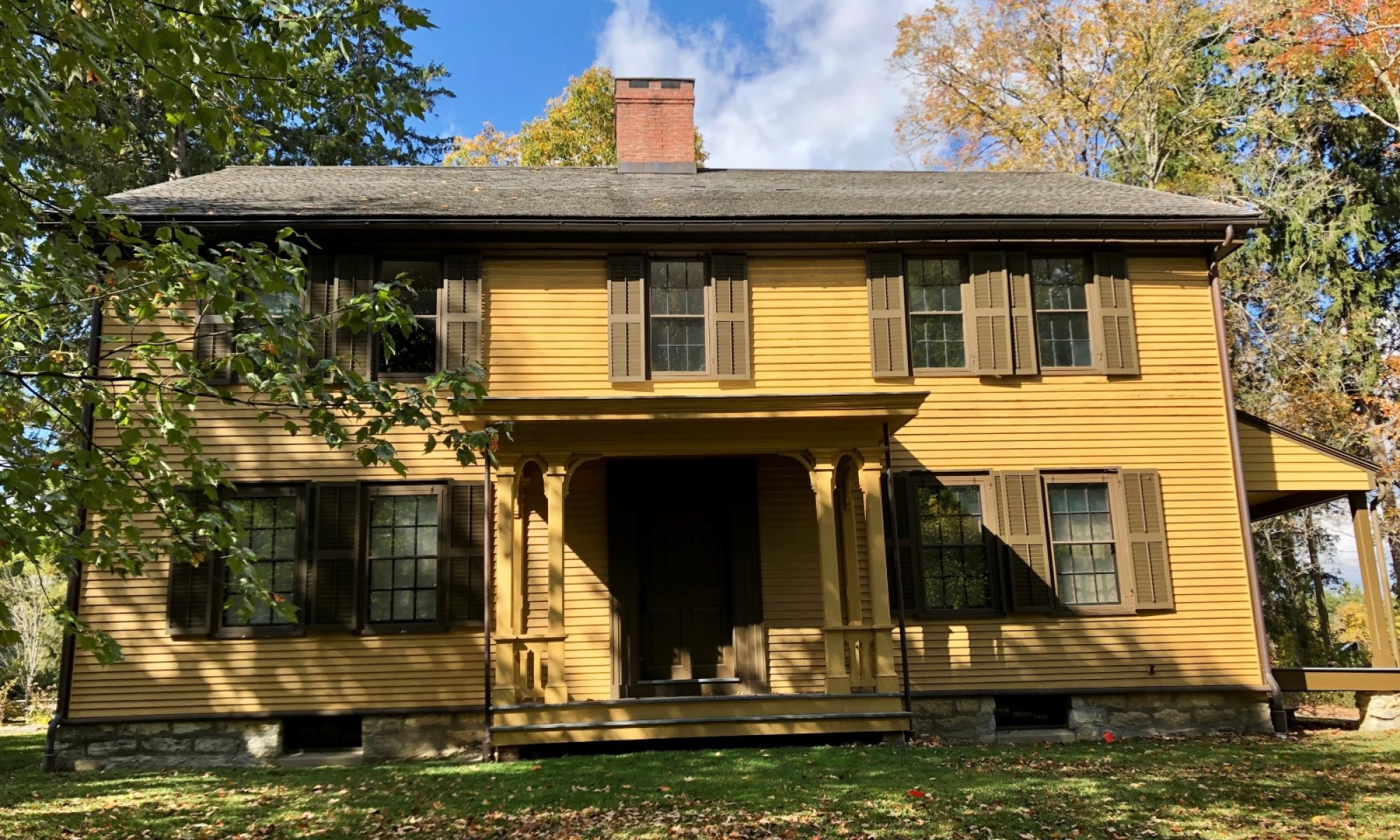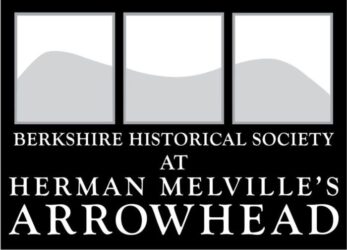 Haying in the North Field, ca. 1870. House and barn in distance.
Haying in the North Field, ca. 1870. House and barn in distance.
To read the 2012 research report about Arrowhead’s Cultural Landscape, click here.
Geology:
The Berkshire Hills are the remnants of the Taconic Orogeny (mountain building event) that occurred approximately 500 million years ago. The bedrock of this portion of Massachusetts is distinctly different than parts East of us as the Berkshires once marked the edge of the North American plate, with all other land mass added in successive tectonic collisions. Over hundreds of millions of years most of this mountain range was eroded by the elements (largely water) and deposited to our West giving the Hudson Valley area its fertile soils.
Fast forward to about 3 million years ago: the planet entered a period of cooling punctuated by brief warming periods causing the polar ice cap to expand and melt alternately. From then until about 13,000 years ago the Berkshires was covered in ice up to a mile in thickness. As the ice expanded it chiseled and ground down the bedrock. When it melted back it left masses of till (rubble of all sizes) and erratics (boulders carried from another area) in its wake. Massive holes left by the glacier as it retreated filled with meltwater to form the beautiful lakes of the area.
The area that is now Pittsfield is located in an upland glacial valley once covered by a patchwork of wetlands and hardwood forest. These forests and wetlands produced and collected organic material forming a thin but rich layer of soil atop the rubbly subsoil and hard metamorphic bedrock.
Pre-European Settlement:
The Mohican people lived here until the late 18th century. “Their lives were rooted in the woodlands in which they lived [in the Hudson River and Housatonic River valleys],” we learn from a Mohican Nation Stockbridge-Munsee Band history. “These lands were covered with red spruce, elm, pine, oak maple and birch trees. They were filled with black bear, deer, moose, beaver, otter, bobcat and mink, as well as turkey and other birds. The clean rivers were filled with fish. Usually the native people built their homes near rivers, so they could be close to food, water and transportation…. While women planted gardens in the spring, the men fished for herring and shad which swam up the river in large schools. From dugout and bark canoes, the men speared or netted fish. During late summer and fall they hunted the animals which were so plentiful in the woods. After the harvest, dried meat and vegetables and smoked fish were stored in pits dug deep in the ground and lined with grass or bark.” For more information about the Mohican people, click here.
European Settlement:
Pittsfield was settled by Europeans starting about 1745, when real estate developers Col. Jacob Wendell and John Stoddard acquired “Pontoosuc Plantation” and set out the first 40 lots. Pittsfield, incorporated in 1761, was an agrarian community. In the early 19th century, Pittsfield was in the forefront of the Merino sheep craze and was the home of the first Agricultural fair in America in 1807. Wool production lead to an abundance of textile mills and other industries powered by our rivers and streams.
European cultivation, including deforestation and wholesale tilling not only halted soil formation in the area it lead to massive erosion of our already sparse topsoil. Not to mention the release of large amounts of carbon into the atmosphere and nitrogen runoff into our lakes and streams. Industrial activity in this area also took its toll on soil, air and water quality.
Arrowhead:
The farm that would later be named Arrowhead was typical of its time. One of Pittsfield’s early settlers, Captain David Bush, acquired the land then built a house in the 1780s on what was (and remains) a busy road between Pittsfield and Lenox. Captain Bush, and perhaps his son Charles, continued farming the land as well as operating a tavern until 1844. Sometime around 1840, the Bushes built the timber-framed barn that still stands on the property.
In 1844, David’s son Charles sold the property to John Brewster, who rented the farm out to tenants. In September 1850, Brewster sold the house, barns, and 160 acres to Herman Melville.
Herman’s jobs included milking and taking care of the cows and the horse, named Charlie. He also had an ox, and a Newfoundland dog. He planted corn, potatoes, hay, tomatoes, and pumpkins, plowed and split wood, and did some carpentry work. He also harvested apples and made cider.
In late 1850, Melville wrote this description of his routine at Arrowhead:
I rise at eight–thereabouts–& go to my barn–say good-morning to the horse, & give him his breakfast. (It goes to my heart to give him a cold one, but it can’t be helped) Then, pay a visit to my cow–cut up a pumpkin or two for her, & stand by to see her eat it–for it’s a pleasant sight to see a cow move her jaws–she does it so mildly & with such a sanctity.–My own breakfast over, I go to my work-room & light my fire–then spread my M.S.S. on the table–take one business squint at it, & fall to with a will. At 2 1/2 p.m. I hear a preconcerted knock at my door, which (by request) continues till I rise & go to the door, which serves to wean me effectively from my writing, however interested I may be. . . .
Melville named the farm “Arrowhead” due to the native artifacts found in the fields.
In 1859, Melville sold about 80 acres to settle debts. In 1863 Herman sold the remaining land and the buildings to his younger brother Allan Melville, a wealthy lawyer. The property stayed in the Allan Melville family until 1927, then a succession of private owners until the Berkshire County Historical Society purchased Arrowhead in 1975 (additional land in 1982). The Society currently owns 45 acres of field and forest. Throughout all this time, the land was used for hay and other crops, though never as a self-sustaining farm.
In 2014 and 2015, farmer Kristen Laney began a CSA farm on the property, including a flock of heritage breed chickens and goats. The approach of this new iteration of the farm was conservation based. Ecologically sensitive techniques were implemented to conserve water, produce new soil, sequester carbon, and generally revitalize this place of both cultural and environmental significance.
Currently, the Berkshire County Historical Society operates Arrowhead as an historic house museum, giving tours of the home in which Herman Melville produced some of his greatest work. It also serves as the headquarters of BCHS, housing offices and a vast collection and archives.

